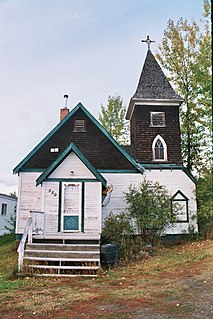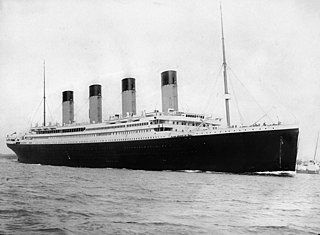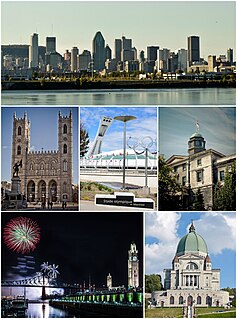
Terrace is a city located near the Skeena River in British Columbia, Canada. The community is the regional retail and service hub for the northwestern portion of British Columbia. With a current population of over 12,000 within municipal boundaries, the city services surrounding communities as well bringing the Greater Terrace Area population to over 18,000 residents. The Kitselas and Kitsumkalum people, tribes of the Tsimshian Nation, have lived in the Terrace area for thousands of years. The individual Indigenous communities neighbor the city with Kitselas to the east and Kitsumkalum to the west.

Hazelton is a village located at the junction of the Bulkley and Skeena Rivers in northern British Columbia, Canada. It was founded in 1866 and has a population of 305 (2011). The nearby larger community of New Hazelton is the northernmost point of the Yellowhead Highway, a major interprovincial highway which runs from Prince Rupert, British Columbia to Portage la Prairie, Manitoba.

Barnard's Express, later known as the British Columbia Express Company or BX, was a pioneer transportation company that served the Cariboo and Fraser-Fort George regions in British Columbia, Canada from 1861 until 1921.
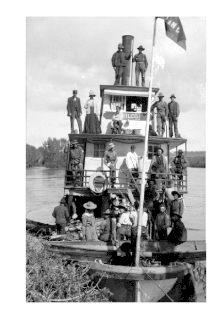
Twelve paddlewheel steamboats plied the upper Fraser River in British Columbia from 1863 until 1921. They were used for a variety of purposes: working on railroad construction, delivering mail, promoting real estate in infant townsites and bringing settlers in to a new frontier. They served the towns of Quesnel, Barkerville and Fort George. Some only worked the Fraser from Soda Creek to Quesnel, while others went all the way to Tête Jaune Cache or took the Nechako River and served Fort Fraser and beyond.

The Skeena River is British Columbia’s fastest flowing waterway, often rising as much as 17 feet (5.2 m) in a day and fluctuating as much as sixty feet between high and low water. For the steamboat captains, that wide range made it one of the toughest navigable rivers in British Columbia. Nevertheless, at least sixteen paddlewheel steamboats plied the Skeena River from the coast to Hazelton from 1864 to 1912.
John Houston was a newspaper publisher and politician in British Columbia.

The Fort Fraser was a small sternwheeler owned by the Fort George Lumber and Transportation Company a partnership originally held by Nick Clarke and Russell Peden from the Fort George town-site of South Fort George. The Fort Fraser was intended to be a small prospecting craft that could service not only the Soda Creek to Fort George section of the upper Fraser River but also the Nechako River and some of its tributaries, enabling her to serve her namesake town of Fort Fraser.

The Conveyor sternwheeler was one of five sternwheelers built for the use on the Skeena River by Foley, Welch and Stewart for construction work on the Grand Trunk Pacific Railway. The other four were the Operator, the Skeena, the Distributor and the Omineca. Three of these, the Conveyor, the Operator and the Distributor were built at Victoria, British Columbia in 1908 by Alexander Watson Jr.

The BX sternwheeler was the first of two river steamers built for service on the upper Fraser River by the BC Express Company during the busy era of Grand Trunk Pacific Railway construction. The BX was built at Soda Creek in early 1910 by Alexander Watson Jr, of Victoria, who was one of British Columbia's foremost shipbuilders and the son of the man who had built the Charlotte. The BC Express Company also hired Captain Owen Forrester Browne to be the master of the BX as he was the most experienced upper Fraser River pilot.

The Operator sternwheeler was one of five sternwheelers built for the use on the Skeena River by Foley, Welch and Stewart for construction work on the Grand Trunk Pacific Railway. The other four were the Conveyor, the Skeena, the Distributor and the Omineca. Three of these, the Conveyor, the Operator and the Distributor were built at Victoria, British Columbia in 1908 by Alexander Watson Jr.

The BC Express was a stern wheel paddle steamer (sternwheeler) that operated on the Fraser River in British Columbia, Canada, from 1912 to 1919. The BC Express was built for the BC Express Company by Alexander Watson, Jr to work on the upper Fraser River between Tête Jaune Cache and Fort George during the busy years of Grand Trunk Pacific Railway construction. The BC Express Company hired Captain Joseph Bucey, an experienced Skeena River pilot, to be her master.

Paddlewheel Park is a small city park on the Fraser River in Prince George, British Columbia, Canada. The park was built in honor of the upper Fraser River sternwheelers that landed there from 1909 until 1921.

New Hazelton is a district municipality on Highway 16 in northwest British Columbia, Canada. It is situated 133 km (83 mi) northeast of Terrace and 68 km (42 mi) northwest of Smithers and in 2016 had a population of 580 people, a decrease of 12.9% comparing to 2011. New Hazelton is one of the "Three Hazeltons", the other two being the original "Old" Hazelton located 4 miles to the northwest very near to the confluence of the Skeena and Bulkley Rivers and South Hazelton, 3 miles to the west.

The Skeena sternwheeler was one of five sternwheelers built for the use on the Skeena River by Foley, Welch and Stewart for construction work on the Grand Trunk Pacific Railway from 1909 until 1911. She was built at Robertson's yard in Coal Harbour, Vancouver, in 1908. The other four were the Conveyor, the Operator, the Distributor and the Omineca. Three of these, the Conveyor, the Operator and the Distributor were built at Victoria, British Columbia in 1908 by Alexander Watson Jr.

John Henry Bonser was a steamship captain from Oregon, United States and British Columbia, Canada. He piloted dozens of sternwheelers over his 40-year-long career and pioneered many rivers in the Pacific Northwest.
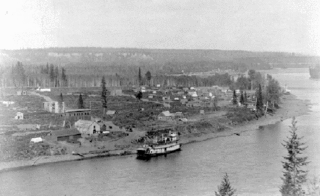
South Fort George is a suburb of Prince George, British Columbia, Canada.
The Millar Addition is a suburb of Prince George, British Columbia, Canada. It is named in honor of its developer, Charles Vance Millar, who later became famous for leaving behind the most notorious will in Canadian history, which was the catalyst for the Stork Derby.

Hazelton was a sternwheeler that worked on the Skeena River in British Columbia, Canada from 1901 until 1912. Her first owner was Robert Cunningham who ran a freighting business that served the communities along the Skeena River.

The Inlander was a sternwheeler that worked on the Skeena River in British Columbia, Canada from 1910 until 1912. She was owned by the Prince Rupert and Skeena River Navigation Company which was a syndicate of Skeena River businessmen who planned to use the Inlander as a passenger and freight steamer during the busy years of Grand Trunk Pacific Railway construction.

